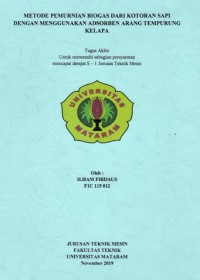
Tugas Akhir Mesin
Metode Pemurnian Biogas Dari Kotoran Sapi Dengan Menggunakan Adsorben Arang Tempurung
Article History: Received Accepted Available online
Indonesia's oil reserves are only about 3.3 billion barrels remaining. If it continues to be consumed without the discovery of new oil reserves, it is estimated that these oil reserves will be exhausted in the next two decades. Biogas is an alternative energy that can be renewed as a substitute for petroleum energy sources. This study aims to determine the effect of flow rates on the purification process using coconut shell charcoal adsorbents on the chemical composition of methane (CH4) and carbon dioxide (CO2) contained in biogas and performance on 110 cc Honda engines. Torque, effective power and fuel consumption as the dependent variable. Flow rate variations (1.34, 2.68, 4.02, 5.36, and 6.7 liters/minute) and loading variations (5, 10, 15, 20 and 25 kgf) as independent variables. Biogas produced from the biogas purification process of cow dung with variations in the flow rate of 6.7 liters/minute produces the highest chemical composition when compared to the flow rate of 1.36 liters/minute, 2.68 liters/minute, 4.02 liters/minute and 5.36 liters/minute, which is the chemical composition of CH4 40.190% and CO2 35.371%. The application of biogas purification on Honda 110 cc absolute revo engine type with open throttle method at 4,500 rpm engine speed was obtained with a flow rate of 5.80 liters / minute (AR10 biogas type) at a maximum load of 25 kgf with 3375 rpm engine speed capable. produces effective power at 4,938.17 Watts, Fuel Consumption (FC) at 1,140 liters / hour, and SFCe at 0.230 liters/hour
Ketersediaan
| 2019213 | 665. 776 .Ilh.m | Tersedia |
Informasi Detail
- Judul Seri
-
-
- No. Panggil
-
665. 776 .Ilh.m
- Penerbit
- Universitas Mataram : Fakultas Teknik Unram., 2019
- Deskripsi Fisik
-
xiv;43 Hlm; 21x29 cm
- Bahasa
-
Indonesia
- ISBN/ISSN
-
-
- Klasifikasi
-
665. 776
- Tipe Isi
-
other
- Tipe Media
-
computer
- Tipe Pembawa
-
audio disc
- Edisi
-
-
- Subjek
- Info Detail Spesifik
-
Pemurnian Biogas Dari Kotoran Sapi Dengan Menggunakan Adsorben Arang Tempurung
- Pernyataan Tanggungjawab
-
Ilham Firdaus
Versi lain/terkait
Tidak tersedia versi lain
Lampiran Berkas
Komentar
Anda harus login sebelum memberikan komentar
 Karya Umum
Karya Umum  Filsafat
Filsafat  Agama
Agama  Ilmu-ilmu Sosial
Ilmu-ilmu Sosial  Bahasa
Bahasa  Ilmu-ilmu Murni
Ilmu-ilmu Murni  Ilmu-ilmu Terapan
Ilmu-ilmu Terapan  Kesenian, Hiburan, dan Olahraga
Kesenian, Hiburan, dan Olahraga  Kesusastraan
Kesusastraan  Geografi dan Sejarah
Geografi dan Sejarah